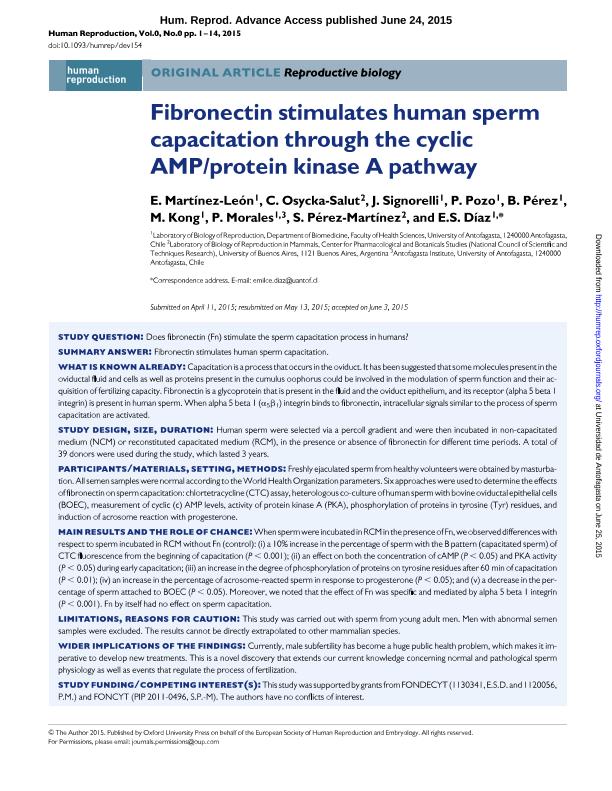Mostrar el registro sencillo del ítem
dc.contributor.author
Martínez León, Eduardo Antonio

dc.contributor.author
Osycka Salut, Claudia Elena

dc.contributor.author
Signorelli, J.
dc.contributor.author
Pozo, P.
dc.contributor.author
Pérez, B.
dc.contributor.author
Kong, M.
dc.contributor.author
Morales, P.
dc.contributor.author
Perez Martinez, Silvina Laura

dc.contributor.author
Díaz, E.S.
dc.date.available
2022-12-27T18:15:45Z
dc.date.issued
2015-09
dc.identifier.citation
Martínez León, Eduardo Antonio; Osycka Salut, Claudia Elena; Signorelli, J.; Pozo, P.; Pérez, B.; et al.; Fibronectin stimulates human sperm capacitation through the cyclic AMP/protein kinase A pathway; Oxford University Press; Human Reproduction; 30; 9; 9-2015; 2138-2151
dc.identifier.issn
0268-1161
dc.identifier.uri
http://hdl.handle.net/11336/182592
dc.description.abstract
STUDY QUESTION Does fibronectin (Fn) stimulate the sperm capacitation process in humans? SUMMARY ANSWER Fibronectin stimulates human sperm capacitation. WHAT IS KNOWN ALREADY Capacitation is a process that occurs in the oviduct. It has been suggested that some molecules present in the oviductal fluid and cells as well as proteins present in the cumulus oophorus could be involved in the modulation of sperm function and their acquisition of fertilizing capacity. Fibronectin is a glycoprotein that is present in the fluid and the oviduct epithelium, and its receptor (alpha 5 beta 1 integrin) is present in human sperm. When alpha 5 beta 1 (α5β1) integrin binds to fibronectin, intracellular signals similar to the process of sperm capacitation are activated. STUDY DESIGN, SIZE, DURATION Human sperm were selected via a percoll gradient and were then incubated in non-capacitated medium (NCM) or reconstituted capacitated medium (RCM), in the presence or absence of fibronectin for different time periods. A total of 39 donors were used during the study, which lasted 3 years. PARTICIPANTS/MATERIALS, SETTING, METHODS Freshly ejaculated sperm from healthy volunteers were obtained by masturbation. All semen samples were normal according to the World Health Organization parameters. Six approaches were used to determine the effects of fibronectin on sperm capacitation: chlortetracycline (CTC) assay, heterologous co-culture of human sperm with bovine oviductal epithelial cells (BOEC), measurement of cyclic (c) AMP levels, activity of protein kinase A (PKA), phosphorylation of proteins in tyrosine (Tyr) residues, and induction of acrosome reaction with progesterone. MAIN RESULTS AND THE ROLE OF CHANCE When sperm were incubated in RCM in the presence of Fn, we observed differences with respect to sperm incubated in RCM without Fn (control): (i) a 10% increase in the percentage of sperm with the B pattern (capacitated sperm) of CTC fluorescence from the beginning of capacitation (P < 0.001); (ii) an effect on both the concentration of cAMP (P < 0.05) and PKA activity (P < 0.05) during early capacitation; (iii) an increase in the degree of phosphorylation of proteins on tyrosine residues after 60 min of capacitation (P < 0.01); (iv) an increase in the percentage of acrosome-reacted sperm in response to progesterone (P < 0.05); and (v) a decrease in the percentage of sperm attached to BOEC (P < 0.05). Moreover, we noted that the effect of Fn was specific and mediated by alpha 5 beta 1 integrin (P < 0.001). Fn by itself had no effect on sperm capacitation. LIMITATIONS, REASONS FOR CAUTION This study was carried out with sperm from young adult men. Men with abnormal semen samples were excluded. The results cannot be directly extrapolated to other mammalian species. WIDER IMPLICATIONS OF THE FINDINGS Currently, male subfertility has become a huge public health problem, which makes it imperative to develop new treatments. This is a novel discovery that extends our current knowledge concerning normal and pathological sperm physiology as well as events that regulate the process of fertilization.
dc.format
application/pdf
dc.language.iso
eng
dc.publisher
Oxford University Press

dc.relation
https://ri.conicet.gov.ar/handle/11336/96702
dc.rights
info:eu-repo/semantics/openAccess
dc.rights.uri
https://creativecommons.org/licenses/by-nc-sa/2.5/ar/
dc.subject
CAPACITATION
dc.subject
CYCLIC AMP
dc.subject
FIBRONECTIN
dc.subject
HUMAN SPERM
dc.subject
PROTEIN KINASE A
dc.subject.classification
Biología Reproductiva

dc.subject.classification
Ciencias Biológicas

dc.subject.classification
CIENCIAS NATURALES Y EXACTAS

dc.title
Fibronectin stimulates human sperm capacitation through the cyclic AMP/protein kinase A pathway
dc.type
info:eu-repo/semantics/article
dc.type
info:ar-repo/semantics/artículo
dc.type
info:eu-repo/semantics/publishedVersion
dc.date.updated
2022-12-27T12:21:12Z
dc.identifier.eissn
1460-2350
dc.journal.volume
30
dc.journal.number
9
dc.journal.pagination
2138-2151
dc.journal.pais
Reino Unido

dc.journal.ciudad
Oxford
dc.description.fil
Fil: Martínez León, Eduardo Antonio. Consejo Nacional de Investigaciones Científicas y Técnicas. Oficina de Coordinación Administrativa Houssay. Centro de Estudios Farmacológicos y Botánicos. Universidad de Buenos Aires. Facultad de Medicina. Centro de Estudios Farmacológicos y Botánicos; Argentina. Universidad de Antofagasta; Chile
dc.description.fil
Fil: Osycka Salut, Claudia Elena. Consejo Nacional de Investigaciones Científicas y Técnicas. Oficina de Coordinación Administrativa Houssay. Centro de Estudios Farmacológicos y Botánicos. Universidad de Buenos Aires. Facultad de Medicina. Centro de Estudios Farmacológicos y Botánicos; Argentina
dc.description.fil
Fil: Signorelli, J.. Universidad de Antofagasta; Chile
dc.description.fil
Fil: Pozo, P.. Universidad de Antofagasta; Chile
dc.description.fil
Fil: Pérez, B.. Universidad de Antofagasta; Chile
dc.description.fil
Fil: Kong, M.. Universidad de Antofagasta; Chile
dc.description.fil
Fil: Morales, P.. Universidad de Antofagasta; Chile
dc.description.fil
Fil: Perez Martinez, Silvina Laura. Consejo Nacional de Investigaciones Científicas y Técnicas. Oficina de Coordinación Administrativa Houssay. Centro de Estudios Farmacológicos y Botánicos. Universidad de Buenos Aires. Facultad de Medicina. Centro de Estudios Farmacológicos y Botánicos; Argentina
dc.description.fil
Fil: Díaz, E.S.. Universidad de Antofagasta; Chile
dc.journal.title
Human Reproduction

dc.relation.alternativeid
info:eu-repo/semantics/altIdentifier/url/https://academic.oup.com/humrep/article/30/9/2138/621893
dc.relation.alternativeid
info:eu-repo/semantics/altIdentifier/doi/http://dx.doi.org/10.1093/humrep/dev154
Archivos asociados
